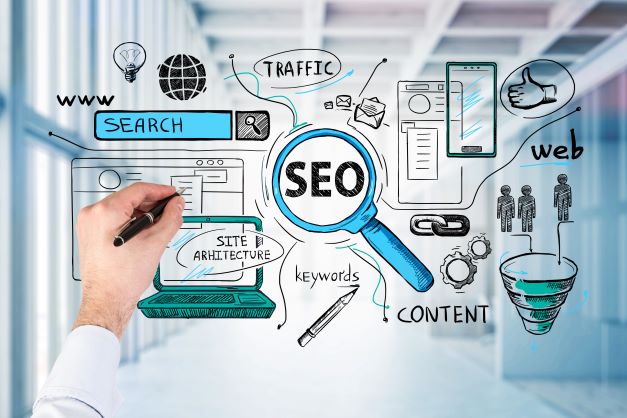Like they always say, pictures are worth 1,000 words. When it comes to SEO, this statement also holds true. Images are an integral part of creating more accessible and attractive content that engages potential clients. Not only do images give search engines important contextual information, optimized images also speed up page loading, which helps to increase user engagement and search engine rankings. To give your business the best opportunity to succeed with SEO, you need to first understand the basics of image optimization.
Image optimization is the practice of creating and sharing high-quality images in the correct format, size, and resolution to boost user engagement and also contributes to a website’s SEO. Image optimization also requires the accurate labeling of images so that search engines crawlers can read them and better understand the page’s context. In 2018, images were found to make up on average 21% of a total web page’s weight. Since images consume more bytes than other parts of a website, the size and details of the image heavily impact site performance.
By reducing the size of an image without altering its quality, page loading times improve, subsequently influencing the experience of the website’s visitors. Studies have found that even just a one-second delay in load time is equivalent to a 7% drop in conversions and about 40% of users will abandon a website that takes over 3 seconds to load. Improved interactions and user experience with your website will ultimately have a positive impact on its search engine rankings, which will further improve customer engagement, customer retention, and conversions. Even better, optimized images actually take up less storage space on your server so site backups can be completed much faster. Below, you will find the 7 best and easiest tips for optimizing images.
-
Resize your images
People often confuse image and file size, but they are not the same thing. Image size is the dimensions on an image, while file size refers to the amount of space required to store the image on your server. Images with both a higher resolution and larger dimensions can slow down your page’s loading time by a significant amount. Although non-optimized images work well for print, images need to be resized in order to be optimized for the internet.
The first easy step to optimize your image for the internet is to choose the correct file format. Some popular formats include JPEG, GIF, and PNG. Many experts recommend JPEG for images with a lot of color and PNG for more simple images. The second easy step is to select the right compression rate. If you compress an image too much, the image file will be small, but the image’s quality will be poor. If you choose a low compression rate, the image’s quality will be higher, but the file size will be much bigger. You can play around with file types in order to find what works best for your images, or you can use an image optimization tool that will automatically minimize the file size while also optimizing the image’s quality. Once you’ve optimized your images, you should then check the loading speed of your website. There are many free and simple to use tools that can be found on the internet that will test your website’s speed.
-
Focus on optimizing image file names
Another easy tip for image optimization is to make sure you optimize the image file names. Before you upload any image to your website, make sure you name the file with both relevant and descriptive keywords. This is an important step to improve your page’s SEO and the image’s ranking in search results. When naming your file, separate the keywords with hyphens. Don’t use underscores because search engines fail to recognize them and won’t be able to see each word individually.
-
Utilize alternative text and tags
Even though your website’s visitors may understand what an image is about, search engine crawlers need a little more help. Without using alternative text, search engines can’t accurately index your image. The best type of alt tag is one that provides context and also helps visually impaired website visitors. Even if images are having trouble loading, search engines are still able to read the alternative text and rank the page. The alt tag should include more detail than the file name. One should aim for about 10-15 words for alternative tags and text.
-
Optimize the image’s title
While some website builders like WordPress will create an image title from the name of your file, you may still need to change it to better explain the image. When renaming, make sure you still use appropriate keywords like you did when coming up with the file name. Although image titles are not as important for SEO, they can still provide additional context to the alternative text. Image titles tend to be more helpful in regards to user engagement, so consider adding a brief call-to-action like “buy now” or “purchase today.”
-
Make sure to include captions
Image captions, which are the words shown directly beneath images, don’t exactly have a direct impact on SEO, but since these captions are visible on your website and can add to the user experience. People use image captions to get a better understanding of what the overall content is about, so without image captions you could end up with higher bounce rates, ultimately damaging your credibility in the eyes of search engines.
-
Try to use unique images
If possible, try to use unique images. Since stock photos are used a lot by other websites, they are not as helpful when it comes to your website’s search ranking. Just like unique written content is better for SEO, so are unique images.
-
Include image structured data
The inclusion of structured data to your web pages aids search engines in displaying your images as rich results. Rich results, also known as rich snippets, are just normal search results with additional data displayed. This extra data is often pulled from the structured data found in a page’s HTML. For example, if you have reviews on your site and you add structured data to your images, Google will add a rich snippet to your search result by showing a star ranking. If you can’t figure this out on your own, there are both websites and plugins you can use to help you out.
Conclusion
Images are incredibly important for Google and the overall user experience of the internet. Images provide a visual representation of the content on a webpage and can convey information in a way that text cannot. They are also an essential component of a well-designed webpage and can help to break up long blocks of text, making the content easier to read and understand.
From a search engine perspective, images are a critical element of search results. Google’s search algorithms use image recognition technology to identify and index images on web pages. This allows Google to display images in search results, making it easier for users to find the information they are looking for.
Furthermore, images can also drive traffic to a website. By optimizing images with relevant alt tags, descriptive file names, and proper image size and formatting, website owners can improve their chances of appearing in Google’s image search results. This can lead to more clicks and higher engagement with their website.
In summary, images are an integral part of the internet and are incredibly important for Google. They improve the user experience by providing visual content, help to break up text, and are a critical component of search results. By optimizing images for search engines, website owners can improve their online visibility and drive more traffic to their site.



